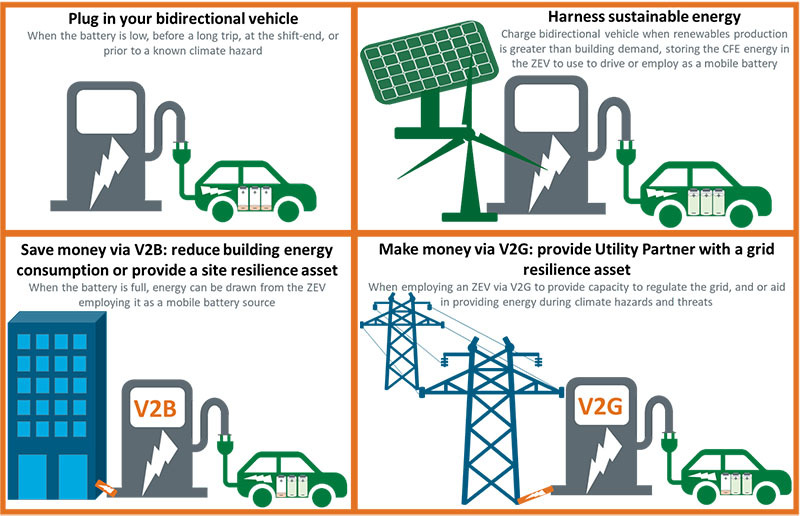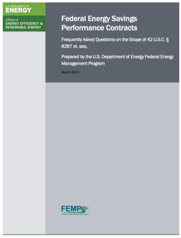
FEMP is excited to announce that Energy Exchange 2022 is now being planned as an in-person event in Fall 2022. The uncertainty associated with the global pandemic creates a challenging environment for planning in-person events. After much deliberation and with input from various stakeholders, FEMP determined the safest way to hold Energy Exchange in-person is to postpone the event from the previously announced August dates and hold the event in the Fall.
|
More information on the dates, location, and technical program will be provided as soon it becomes it available. We can’t wait to see everyone in-person in the Fall.
Registration is open and the agenda for the virtual Federal Utility Partnership Working Group (FUPWG) Seminar scheduled for May 3-4, 2022 can now be viewed on the FUPWG website. FEMP’s Director, Mary Sotos will kick off the meeting and introduce Dr. Carolyn Snyder, DOE’s Deputy Assistant Secretary for Energy Efficiency in the Office of Energy Efficiency and Renewable Energy, who will present the Washington Update. Andrew Mayock, the Federal Chief Sustainability Officer leading President Biden's efforts to improve the sustainability of the Federal government will deliver an important Council on Environmental Quality update.
FUPWG provides a venue for information exchange and training that fosters effective partnerships between federal agencies and their serving utilities to develop solutions which leverage private sector investment in federal facility infrastructure to improve energy and water efficiency and support federal building decarbonization. All are invited to attend this no-cost virtual event. Last year’s virtual FUPWG had over 850 participants and we anticipate an even larger attendance this year. Continuing Education Units (CEUs) will be offered.
Additional FUPWG Seminar highlights include:
- New Federal Energy Goals and Requirements
- Federal Agency and Department of Defense Updates
- Utility Industry Perspectives, Priorities, and Other Updates
- UESC Best Practices
- Roadmap to Implementing Climate and Resilience Goals: Federal Agency Solutions
- Transacting for 24/7 Carbon Free Energy
- Electric ECM Opportunities


EVSE Tiger Team Charts Success for Golden Gate National Recreation Area
FEMP’s Fleet team successfully kicked off their FY22 FEMP-funded Electric Vehicle Supply Equipment (EVSE) Tiger Team Site Assessments with Golden Gate National Recreation Area days before the federal sustainability executive order (E.O. 14057) hit the streets. This historic NPS site put the pedal to the metal during the 3-month site assessment, successfully working closely with FEMP and NREL zero-emission vehicle experts to determine optimal siting for EVSE at their Fort Cronkhite and Fort Mason locations. This assessment provided the site with cost estimates for installing EVSE for government-owned vehicles and personally-owned vehicles. It also informed FEMP and NREL’s EVSE planning tool during its development phase to ensure the tool serves a variety of sites for a whole-of-government approach. Read more about this success story and others.
|
Updated: Federal Workplace Charging Program Guide
The recently updated Federal Workplace Charging Program Guide helps federal agencies develop policies for workplace charging at their facilities. It offers language that agencies can incorporate into policy documents to define requirements for charging privately owned vehicles on government-owned or leased property and describes various scenarios in which fees should be imposed to cover costs of electricity, EVSE units, and installations.
Two calculators are provided in the Federal Workplace Charging Guide:


New: Managed EV Charging, Bidirectional Charging, and EVs for Mobile Storage
FEMP has expanded its fleet website to include a new section focusing on managed electric vehicle (EV) charging and bidirectional EV charging. These technical resources can support fleet electrification while also saving sites money through demand shifting and electricity costs depending on time of use, as well as enhance site decarbonization and resilience. Managed EV charging can control the charging time and amount depending on EV needs, site demand, and energy price signals. Bidirectional charging can discharge power from EV to the site that can further enhance load management and building resilience. This electric vehicle supply equipment (EVSE) when employed for load management may be an eligible ECM through FEMP performance contracting programs.
|

New: Electric Vehicle Utility Finder (EV U-Finder)
FEMP’s EV U-Finder Tool has launched, connecting fleet managers with their local utility to identify cost-effective incentives for fleet electrification.
Upon entering a zip code in the Excel lookup tool, EV U-Finder provides information about electric vehicle supply equipment (EVSE) funding opportunities and contacts for local utilities as well as Clean Cities coalitions operating in the zip code.
|
Become an EV Subject Matter Expert with the EV Champion Training Series
This four-part training series serves as an introduction to electric vehicle technology and considerations for EVSE installation. This course focuses on the selection of the best EVs for your fleet and planning for the installation of EVSE that will serve the needs of these new vehicles.
All trainings are held from 10:00 AM–12:00 PM EDT. Select from the trainings below to register.


ESPC Helps Coast Guard Plan for Off-the-Grid Resilience and Significant Savings
The Defense Logistics Agency (DLA) Energy awarded a $48 million energy savings performance contract on behalf of the U.S. Coast Guard. The renewable energy microgrid, located at Coast Guard Training Center (TRACEN) Petaluma, broke ground in late January and will be paid for with the energy savings generated over a 23-year contract term. The goal of the project is to allow TRACEN Petaluma to be able to produce their own power for up to 10 days of independent and full operations through the installation of 5 MW of solar photovoltaic panels and 11.6 MWh of battery storage. TRACEN Petaluma leveraged FEMP technical assistance, AFFECT grant funding, as well as an Energy Sales Agreement to increase the project’s impact. Read the Coast Guard's news release.
|

FEMP Releases New ESPC Guidance on Including Electric Vehicle Supply Equipment and Electric Vehicles Within a Project
FEMP is pleased to announce the release of the updated document, Federal Energy Savings Performance Contracts: Frequently Asked Questions on the scope of 42 U.S.C. § 8287 et seq. The document provides clarification and guidance on common questions regarding the scope of energy savings performance contracting (ESPC) statutory authority to assist federal agencies in executing successful ESPC projects. The latest update includes clarifications to existing frequently asked questions (FAQs) with inclusion of recent ESPC amendments that have been enacted by statute, as applicable. New FAQs, 32 through 36, have been added that address operation and maintenance, projects in privately leased buildings, and renewable energy credits (FAQ 32, 33, & 34, respectively).
Also included is long-awaited new guidance regarding the inclusion of Electrical Vehicle Supply Equipment (EVSE) within ESPCs and a discussion of the limited circumstances where there may be an opportunity for components of electric vehicles (EVs) to be included in an ESPC (FAQ 35 & 36, respectively).
|

Weighing renewable energy options? Opt into REopt®. Formerly known as REopt Lite®, NREL’s REopt web tool is dropping the “Lite” from its name to better reflect its status as a comprehensive techno-economic optimization tool. REopt helps federal energy managers evaluate the economics of distributed solar, wind, battery storage, combined heat and power, geothermal heat pumps, modeled greenhouse gas reductions…the list goes on.
This new fact sheet highlights best practices for supporting Energy Management Information Systems (EMIS) operations in federal facilities. FEMP promotes best practices for impactful utilization of EMIS, as detailed in the EMIS Technical Resources Report, and this fact sheet is part of a series of best practices documents created to help accelerate the market adoption and use of EMIS in the federal sector.
This new FEMP video walks federal energy managers and agency leaders through the energy savings performance contract energy sales agreement (ESPC ESA) project structure and benefits.
To help federal employees better utilize existing shuttle services, FEMP developed an interactive map to navigate shuttle stops in the Washington, DC, area. Federal employees can view the shuttle services as individual stops or as the estimated route patterns. When further resources are available online for a specific shuttle, users can click on a specific route or stop to access information such as timetables and contact information.
This PNNL technical paper provides an approach to determining the value of resilience for a particular site. The monetary value of resilience for electricity and water, which varies between sites, can help provide the financial justification for resilience investment decisions. These investment-grade valuations are often a key step in federal project procurement processes. Today, many federal agencies are unable to include resilience benefits in these processes, thus potentially undervaluing the benefits to the facility, site, or agency from a proposed scope of work. The approach described in this report provides a methodology for getting toward a dollar figure for decision-making within institutional processes and enables a benefit/cost analysis of different resilience solutions, compares them with the baseline, and presents the results of the analysis to the decision maker.

Visit the FEMP Training Catalog to view all available live and on-demand trainings.
Financing and Financial Proposal Review
April 5, 2022 1:00 pm-2:30 pm | Register to Attend
This training provides an in-depth overview of financing for energy savings performance contracts (ESPCs), including where the financing comes from, what's in the payments and how they break down, and details about the amount financed. Attendees gain a strong understanding of the ESPC indefinite-delivery, indefinite-quantity (IDIQ) financing process; components of the interest rate; and strategies to reduce interest costs.
Pricing in Energy Savings Performance Contracts (ESPC)
April 12, 2022 1:00 pm-2:30 pm | Register to Attend
This training discusses how agencies can maximize the scope of energy savings performance contracts by analyzing implementation price and negotiating a contract price that is fair and reasonable in accordance with FAR 15.4. An overview of price and cost-analysis techniques are provided.

|